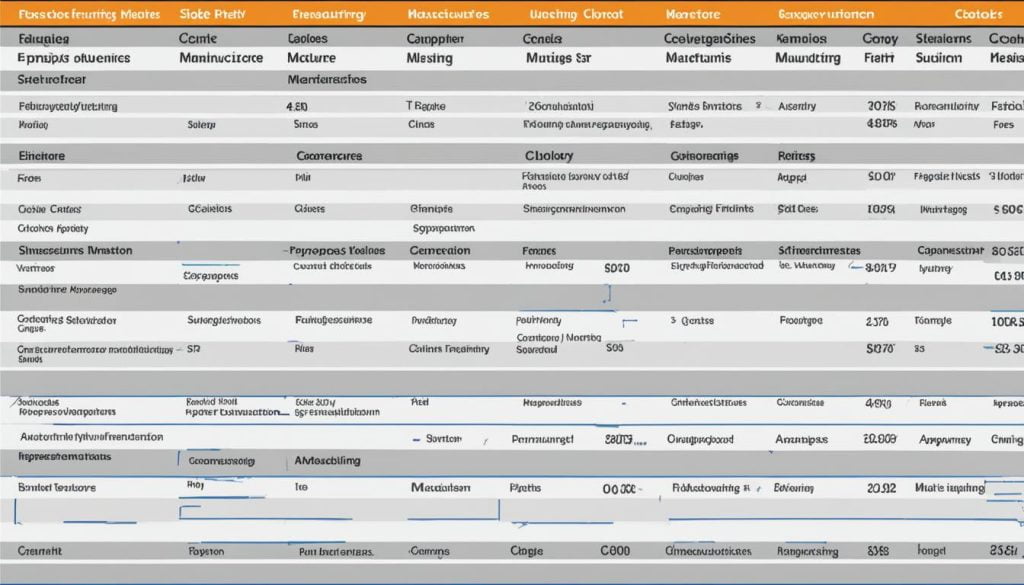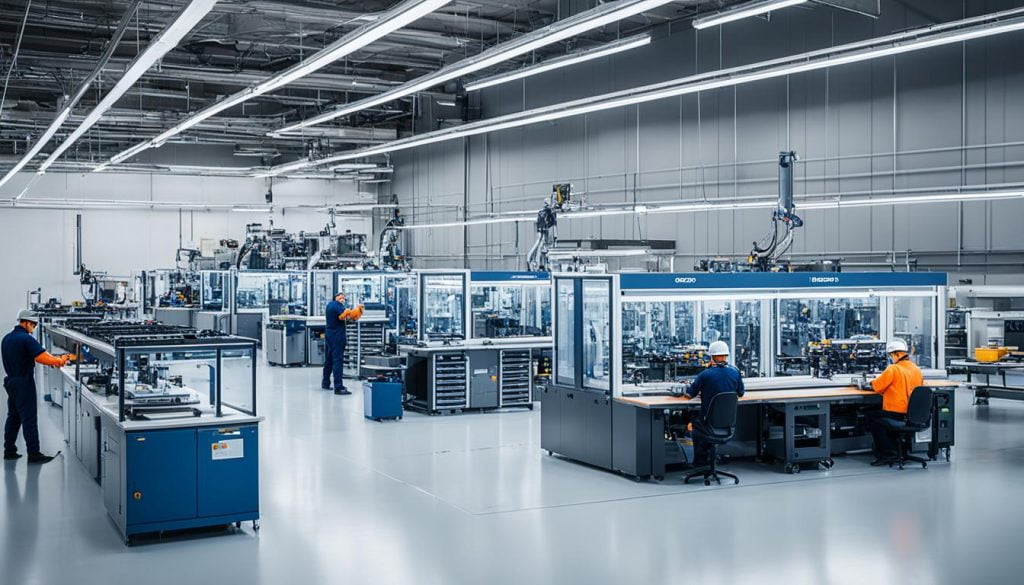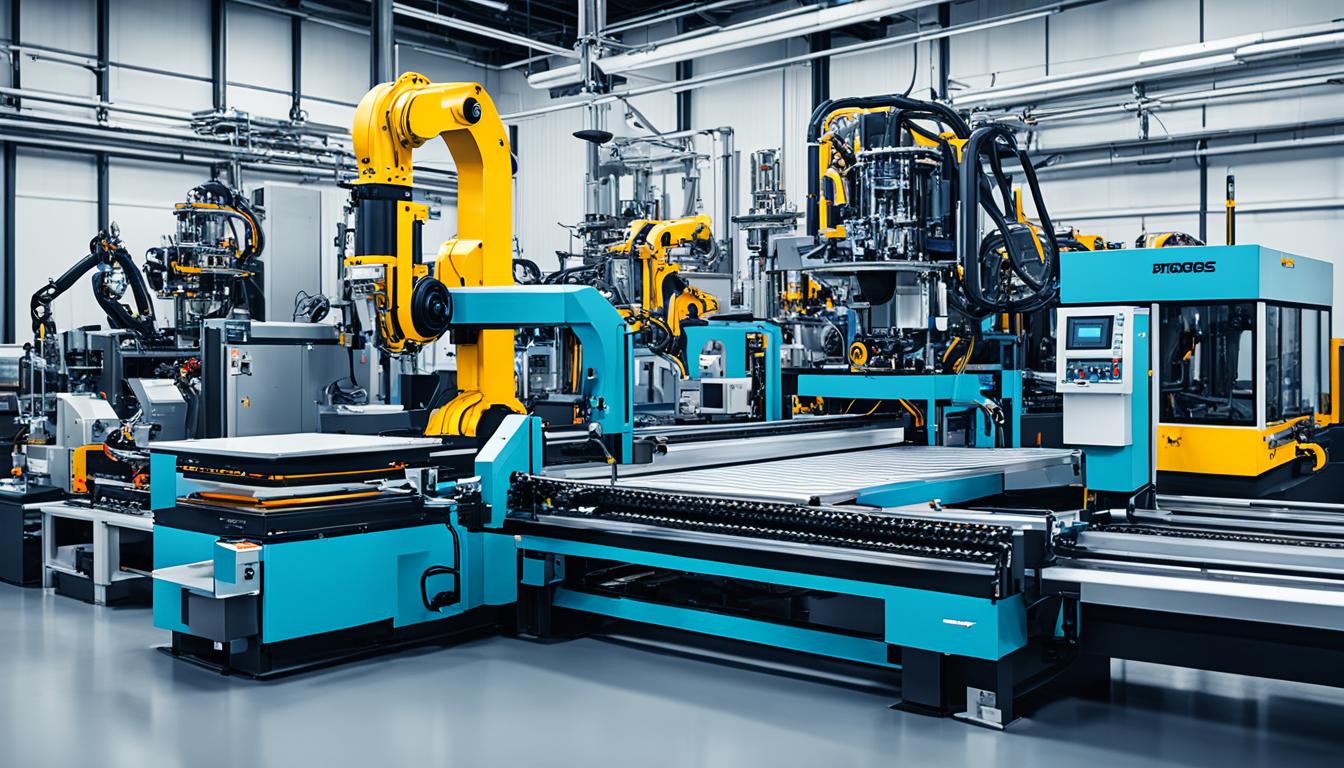As the manufacturing landscape evolves, you, the forward-thinking industry leader, must stay ahead through meticulous Comparative Manufacturing Practices. Whether your focus is on streamlining production, maximizing efficiency, or integrating sustainable methodologies, understanding and implementing the gold standards of manufacturing industry standards is indispensable. This quantifiable edge—achieved through comparative performance evaluation—is not merely about keeping pace but about setting the benchmarks that define tomorrow’s industry standards.
Harness the power of comparative insights to navigate the complexities of production dynamics and consumer expectations. Position your operations at the frontlines of innovation and productivity, and let’s unveil the strategic benefits that comparative methodologies can bring to your manufacturing processes.
Key Takeaways
- Grasp the essence of Comparative Manufacturing Practices and its significance in the industry.
- Recognize the influence of global trends on manufacturing efficiency and sustainability.
- Identify the advantages of leveraging comparative evaluations for a competitive edge.
- Discover the impact of consumer demand on the evolution of manufacturing standards.
- Understand the intersection of industry benchmarks and performance improvements.
Understanding Comparative Manufacturing Practices
In today’s highly competitive manufacturing sector, the ability to conduct a thorough manufacturing process analysis is essential for identifying areas of improvement and implementing the most efficient production methods. By engaging in production methods benchmarking, businesses can measure their processes against those of industry leaders to uncover new strategies for improvement.
Comparative Manufacturing Practices (CMP) serve as a cornerstone for businesses looking to enhance their supply chain optimization strategies. Through CMP, you have the tools necessary to scrutinize and refine processes, solve productivity puzzles, and achieve operational excellence.
Why are these practices so beneficial? They help in:
- Conducting comprehensive analysis to spot inefficiencies
- Learning from best practices within your industry and others
- Prioritizing areas for immediate action and those for strategic development
By understanding the nuances of Comparative Manufacturing Practices, you empower your business to engage in a continuous cycle of evaluation and improvement. Whether that means re-assessing your supply chain for potential vulnerabilities or benchmarking your production efficiency, CMP lays a solid foundation for data-driven decision making and long-term success.
Remember, optimizing your manufacturing process is an ongoing journey, not a one-time fix. It requires persistence, innovation, and a willingness to learn from both successes and failures.
Key Factors in Manufacturing Efficiency Comparison
As you delve deeper into the intricate world of manufacturing, understanding the subtle and overt differences in efficiency becomes crucial. It’s not just about how machines operate; it’s about the overall harmony between various elements that constitute your manufacturing ecosystem. Your journey towards enhanced production begins with identifying key areas that are ripe for improvement and recognizing the balanced interplay between qualitative and quantitative metrics that define your operational success.
Identifying Areas for Process Improvement
Embarking on a manufacturing efficiency comparison necessitates a meticulous analysis of your existing processes. It’s imperative to scrutinize production rates and evaluate output quality to identify bottlenecks. One must consider machine downtime, supply chain lags, and even employee turnover rates. Opportunities for waste reduction should be pursued relentlessly, as these can be transformative in achieving cost-effective production lines. Such a comparative performance evaluation serves as a linchpin in pivoting towards more sustainable practices, directly impacting your bottom line.
Quantitative vs Qualitative Metrics in Manufacturing
Every cog in the manufacturing wheel plays its part; thus, a comprehensive comparison must weigh both quantitative and qualitative metrics. Quantitative data empowers you with statistical evidence—production volume, time efficiency, and manufacturing cost analysis present a clear picture of where the numbers stand. However, qualitative aspects like workforce satisfaction and product quality often tell a more complex story that numbers might miss. A careful blend of these perspectives furnishes a complete view of your manufacturing operations, guiding you towards smarter, data-informed decisions.

Ultimately, consistently applying these factors to your manufacturing processes facilitates an environment of continuous improvement. Your enterprise can not only sustain its current operations more effectively but also adapt rapidly to market changes and technological advancements—staying ahead in a competitive landscape.
Adopting Best Practices in Manufacturing
In the pursuit of industrial excellence, the drive towards adopting best practices in manufacturing is not a static effort, but a dynamic process that demands continuous improvement and adaptability. The ultimate aim is to establish a standard of performing tasks and managing processes that leads to increased efficiency, quality, and performance.
Staying attuned to manufacturing industry standards not only ensures compliance but also acts as a foundation upon which processes can be analyzed and improved. A commitment to excellence propels organizations forward, pushing them to embrace innovative solutions and practices proven to yield successful outcomes.

For instance, a comparative process analysis can serve as an insightful exercise to identify strengths and weaknesses within your current manufacturing paradigm. Such analyses often entail:
- Assessment of current workflows against industry benchmarks
- Identification of bottlenecks or inefficiencies
- Exploration of new technologies and processes that can streamline operations
Below is an example that illustrates how comparative process analysis can be documented to facilitate decision-making:
| Process Element | Current State | Industry Standard | Proposed Improvements |
|---|---|---|---|
| Production Time | 30 hours | 25 hours | Implementing automated assembly |
| Material Waste | 5% | 3% | Applying lean manufacturing principles |
| Quality Control Failures | 2% | Integrating Six Sigma methodologies |
Adopting best practices also revolves around a proactive culture where employees at all levels are encouraged to contribute ideas for improvement. Through this collective effort, a company can align its operations with leading standards and, more importantly, set a course for a sustainable and profitable future.
As you navigate the complex landscape of modern manufacturing, consider the wealth of success stories that have been shaped by a dedication to best practices. Such dedication is a testament to the potential that lies in standardized excellence—where the application of refined processes and a mindset of quality can elevate any operation to new heights.
Manufacturing Process Analysis and Optimization
When you set out to streamline your manufacturing process, a detailed analysis is the first step towards substantive improvement. Techniques such as Lean manufacturing and Six Sigma have been developed over the years specifically to target inefficiencies and drive process optimization. By implementing these methodologies, you can initiate a culture of continuous improvement and statistical rigor in your operations.
Utilizing Lean Manufacturing Techniques
Lean manufacturing is all about adding value to your customer without any wastage. The foundational principle of Lean is to strip your process down to what is essential, eliminating anything that does not directly contribute to the end product. In a practical sense, lean manufacturing techniques can manifest as reduced inventory levels, simplified production steps, or implementing pull systems that respond directly to customer demand. The core idea is that every process should have a purpose, and everything else is a candidate for reevaluation and elimination.
Employing Six Sigma for Process Enhancement
While Lean focuses on waste reduction, Six Sigma‘s goal is to reduce process variability. In Lean, you will use tools like the 5S system, while Six Sigma uses a data-driven approach, encapsulated in its DMAIC (Define, Measure, Analyze, Improve, Control) methodology. This is based on creating a disciplined, data-driven approach towards eliminating defects. By adopting Six Sigma, you align your processes closer to perfection, which means fewer defects, reduced cycle times, and increased customer satisfaction.
| Objective | Lean Manufacturing Techniques | Six Sigma Methodologies |
|---|---|---|
| Primary Focus | Eliminating Waste | Reducing Variability |
| Tools Used | 5S, Kanban, JIT | DMAIC, FMEA, Pareto Analysis |
| Outcome Expected | Streamlined Process, Reduced Inventory | Improved Quality, Lower Defects |
| Impact on Efficiency | Simplifies Operations, Minimizes Delays | Optimizes Performance, Enhances Product Quality |
Conducting a thorough manufacturing process analysis can reveal which technique—or combination thereof—can most effectively increase manufacturing efficiency. Comparing the impact of Lean and Six Sigma often leads to the discovery that integrating these strategies provides a comprehensive approach. By combining Lean’s agility with Six Sigma’s precision, you establish a robust system for ongoing excellence in manufacturing practices.
Production Methods Benchmarking Across Industries
As you continue to navigate the competitive landscape of manufacturing, understanding and applying production methods benchmarking is essential. By closely examining how your methods stack up against those of industry leaders, you leverage invaluable insights to streamline operations and enhance productivity. This section unveils insights from case studies on manufacturing strategies that set the bar in various sectors and introduces an array of benchmarking tools and resources to propel your strategy forward.
Case Studies on Successful Manufacturing Strategies
Let’s explore several illustrative examples where companies have outpaced competitors through strategic benchmarking:
- Toyota’s Lean Manufacturing, which highlights waste reduction and has revolutionized automotive production.
- Intel’s adoption of Six Sigma, showcasing commitment to quality and precision in the technology sector.
- The pivot of GE Appliances to connected factory floors, facilitating real-time monitoring and incremental improvements.
Benchmarking Tools and Resources
Equip your business with the right tools to conduct effective benchmarking analysis:
| Tool | Feature | Industry Application |
|---|---|---|
| APQC’s Process Classification Framework | Comprehensive process benchmarking across industry sectors | Cross-industry |
| Benchmarking Network, Inc. | Customized reports and targeted performance data | Various, including energy, healthcare, finance |
| iBenchmarking | Peer comparison and best practice identification | Manufacturing specific |
Adopting these tools will help you to not only understand where improvements can be made but also to visualize the path towards becoming a best-in-class manufacturing operation. Whether you are a small enterprise or a multinational corporation, these resources are instrumental in driving strategic, data-driven changes.
Comparative Performance Evaluation in Manufacturing
As you navigate the complexities of the manufacturing sector, understanding the power of comparative manufacturing practices is essential. These practices enable thorough manufacturing cost analysis and foster informed strategic planning. Integrating comparative performance evaluation into your routine can be transformative, highlighting cost inefficiencies and paving the way for significant process enhancements.
Regularly assessing operational performance through these evaluations can reveal valuable insights that drive smarter, evidence-based decision-making. An established evaluation framework is crucial for monitoring progress and making necessary adjustments in sync with market trends and new technologies. Let’s explore how comparative performance evaluations can impact your manufacturing processes.
Regular evaluation paves the road to excellence. It is the beacon that guides manufacturing entities towards optimal efficiency and groundbreaking innovations.
Manufacturing Cost Analysis: One of the critical components of comparative performance evaluation is a detailed cost analysis. This involves a granular look at production expenses, material costs, and overheads, identifying areas where financial savings can be harnessed without compromising product quality.
- Investment in advanced machinery
- Adoption of cost-saving materials
- Refinement of labor processes
Here is how a Comparative Performance Evaluation can be structured:
| Performance Metrics | Current State | Industry Average | Target Benchmarks |
|---|---|---|---|
| Production Throughput | 250 units/hr | 300 units/hr | 350 units/hr |
| Defect Rates | 5% | 3% | |
| Operational Costs | $50,000/mo | $45,000/mo | $40,000/mo |
| Employee Productivity | 100 units/employee | 120 units/employee | 150 units/employee |
Embrace the evolving paradigms of efficiency by employing a continuous loop of assessment and improvement. Align your operations with the best in the field, and establish an enduring legacy of quality and innovation in manufacturing.
Conclusion
In the dynamically evolving world of manufacturing, the embrace of Comparative Manufacturing Practices is not merely advantageous, it is vital. Throughout this article, we have traversed the terrain of evaluating and enhancing production workflows, emphasizing the role of best practices in manufacturing. By adopting these methodologies, you pave the way not only for increased efficiency but also for the longevity of your operational success.
As you reflect on your current operational procedures, consider the strength of supply chain optimization strategies. They stand as cornerstones for facilitating seamless production lines and meeting the rigors of manufacturing industry standards. It is through the rigorous process analysis and adoption of data-driven strategies that your manufacturing business can achieve remarkable improvements in performance, cost-savings, and customer satisfaction.
Let this exploration serve as a call to action, propelling you to invest in and commit to continuous improvement. To thrive in both domestic and international markets, align your practices with the global standards that drive competition and innovation. By integrating these principles and staying agile in the face of industry shifts, your manufacturing enterprise will not only endure but also flourish.
FAQ
What are Comparative Manufacturing Practices?
Comparative Manufacturing Practices (CMP) involve the assessment and comparison of various manufacturing processes within an industry or between industries. By evaluating efficiency, cost-effectiveness, and overall performance, CMP helps to identify best practices that a company can adopt to improve its competitive edge, meet consumer demands, and incorporate sustainable operations.
Why is understanding Comparative Manufacturing Practices important?
Understanding CMP is crucial as it provides manufacturers with insight into more efficient and cost-effective production methods. Through process analysis, benchmarking, and supply chain optimization strategies, companies can discover areas that need improvement, streamline operations, and stay competitive in an ever-evolving marketplace.
What factors are critical in manufacturing efficiency comparison?
Manufacturing efficiency comparison takes into account a range of factors, including production output rates, resource utilization, waste reduction, and downtime. Both quantitative metrics like time, cost, and volume, along with qualitative metrics such as employee satisfaction and product quality, are essential for a comprehensive evaluation of a company’s performance.
How can manufacturers adopt best practices in their operations?
Manufacturers can adopt best practices by aligning with industry standards, continuously analyzing and refining processes, and leveraging proven methods such as Lean and Six Sigma. Staying informed about technological advancements and regularly benchmarking against industry leaders also contribute to the adoption of best practices.
What is the role of Lean manufacturing techniques in process optimization?
Lean manufacturing techniques prioritize the elimination of waste within manufacturing systems while ensuring quality and value to the customer. These techniques foster a culture of continuous improvement, enhancing production efficiency and reducing unnecessary costs.
How does Six Sigma contribute to manufacturing process enhancement?
Six Sigma is a data-driven approach aiming to reduce process variability and defects, leading to an improvement in overall quality. By employing Six Sigma methodologies, manufacturers refine their processes, leading to more consistent output and greater customer satisfaction.
What benefits do production methods benchmarking offer to industries?
Production methods benchmarking allows companies to compare their performance with industry leaders and peers, gaining insights into more effective manufacturing strategies and techniques. This comparison helps set realistic goals, motivate improvements, and guide strategic decision-making based on successful practices.
Why is regular comparative performance evaluation necessary in manufacturing?
Regular comparative performance evaluation helps manufacturers identify cost inefficiencies, uncover opportunities for process enhancement, and make informed decisions. It provides a framework for ongoing improvement and adaptation to market trends and technological changes, ultimately driving business growth and success.







